Byzantine 21-01-2004 Handout and Slides
Dr Cecily Hennessy Classical Tradition: Byzantine In Early Christian representations we saw a move away from Greek and Roman myth towards biblical narrative and symbol and the increasing patronage of the Church as well as the imperial family. In terms of style, Early Christian art is often associated with abstraction and symbolism, although the naturalism and illusionism frequently attributed to Classical art is still present. This lecture will consider to what extent Byzantine art perpetuates or re-appropriates classical subjects and modes of representation and in what ways it may react against it. We look at icons, focusing on those at St. Catherine'’s monastery in the Sinai, Egypt, founded by Justinian after Theodora’s death in 548, and then at early mosaics in the Church of St. Demetrios in Thessalonki. We discuss the eighth- and ninth- century movement condemning figural representation, looking at a church decorated during Iconoclasm, St. Eirene in Istanbul, and at the subsequent mosaic decoration at the Great Church, St. Sophia, in Istanbul. We then turn to post- iconoclastic manuscripts, from the ninth and tenth centuries, and finally to the mosaic decorations of the churches of the monasteries of Hosios Loukas, and of Chora (Kariye Caami).
Slide 1: Haghia Sophia, Istanbul, 532-537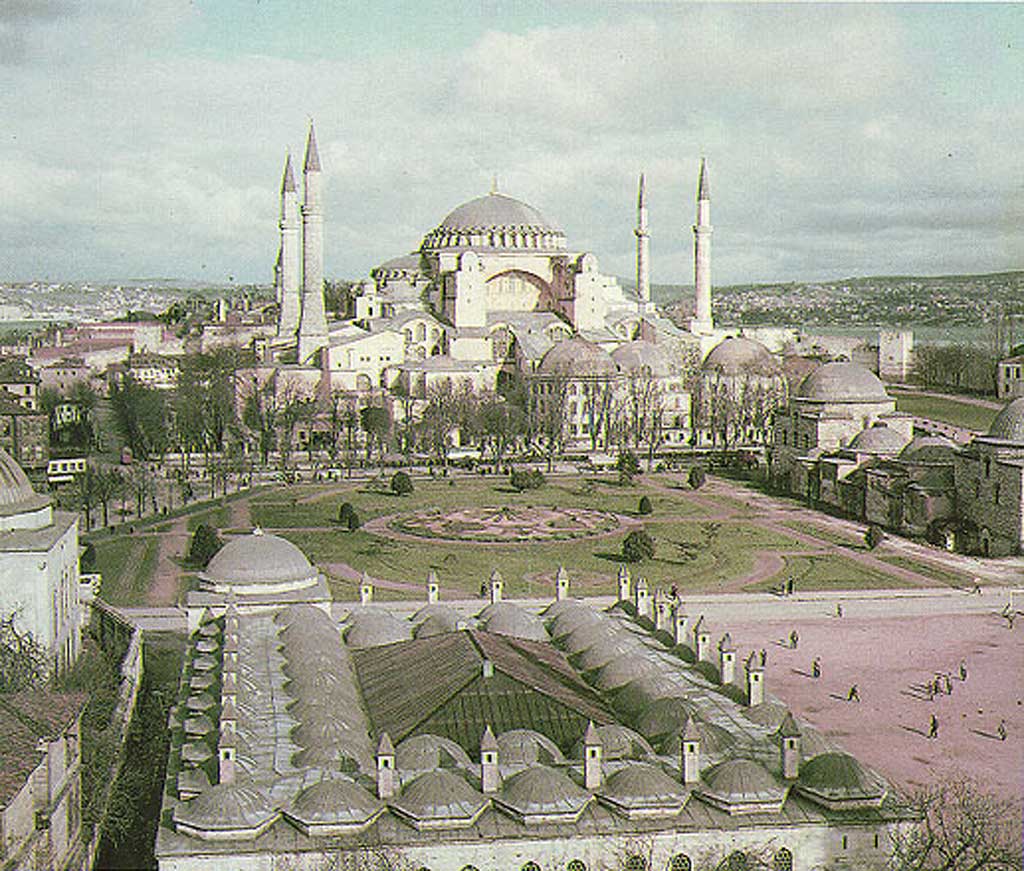
built by Justinian, plan, section Haghia Sophia, Virgin and Child, apse, 867
Slide 2: Haghia Sophia, mosaic above central door
This scene depicts Jesus sitting on a magnificent celestial throne. His right hand is raised in a gesture of blessing, and in His left hand He holds an open book bearing the inscription: Peace be with you. I am the Light of the World. On either side of Jesus, there are roundels. The one on the left portrays the Virgin Mary, and that on the right portrays the angel Gabriel. Jesus, potrayed here as the Pantocrator (King of the World), is dressed in white hiton and himation, and his features resemble Zeus, the king of gods.
The latest research revealed that the bearded emperor prostrate on Jesus’ lower left represents Emperor Leon VI. Although the scene is uncharacteristic of Byzantine iconography, the emperor is depicted imploring Christ ‘s forgiveness.
The subject of the scene is the three marriages of Leo VI, a situation contrary to the doctrine of the Orthodox church. Since the emperor was still without a male heir even after three marriages, he was allowed to marry his mistress Zoe, the mother of his illegitimate son, after a long dispute.
between narthex and church, Christ and emperor, probably Leo IV, ca. 900
Slide 3: Haghia Sophia, mosaic of Constantine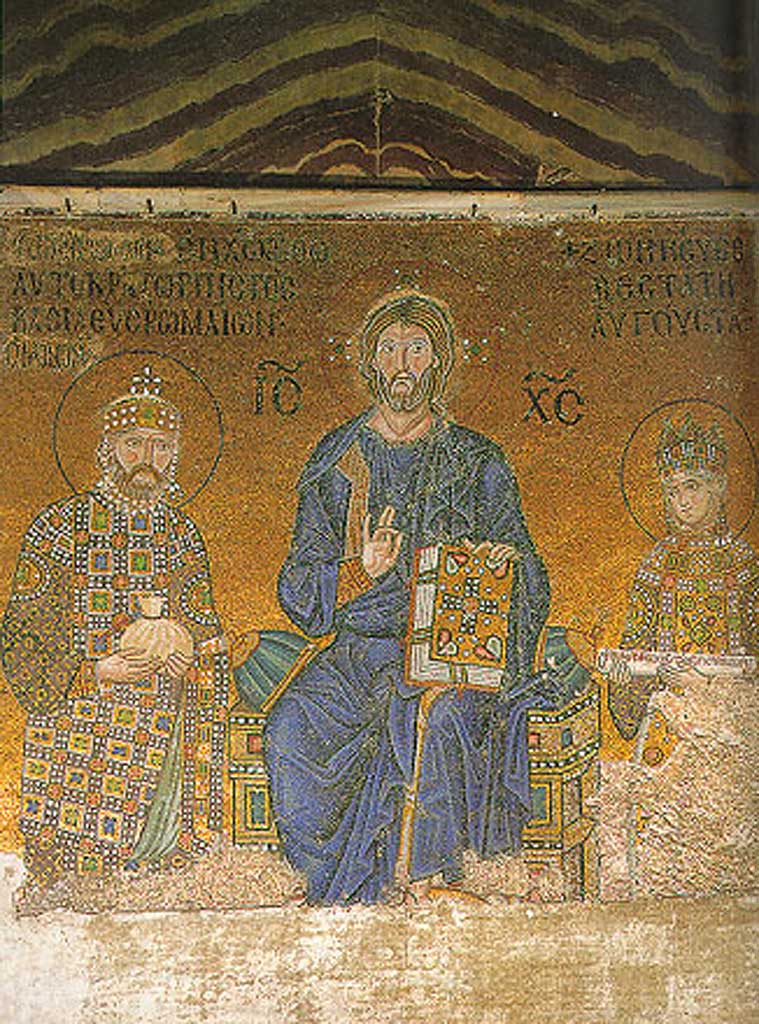
Justinian and Virgin, lunette of vestibule, early 10 Century
Slide 4: Haghia Sophia, South gallery, Zoe and Constantine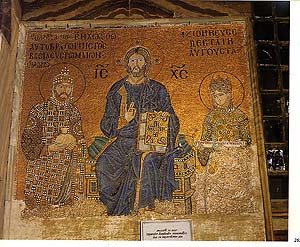
LX Monomachos and Christ, 1028 – 34 and 1042-55 (originally showed first husband Romanos III Argyros)
Slide 5: Haghia Sophia, Deisis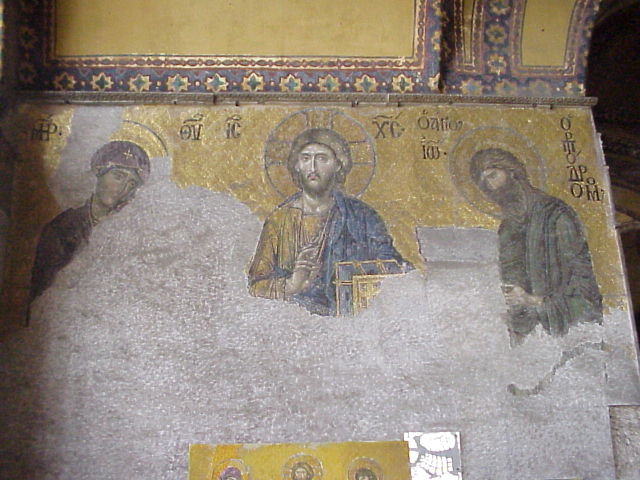
shortly after 1261
Eusebius, Bishop of Caesarea
I have examined images of the apostles Paul and Peter and indeed of Christ himself in paintings presumably men of old were heedlessly wont to honour them in their houses
Slide 6: St Catherine'’s Monastery, Sinai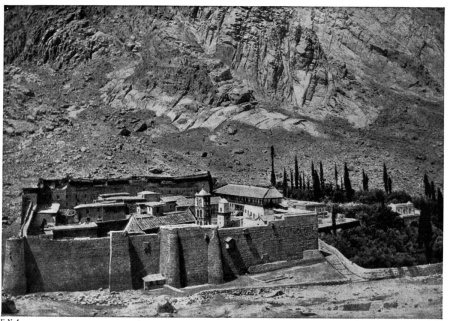
built by Justinian, 548 – 565
Slide 7: St Catherine'’s Monastery, Sinai, Virgin and Child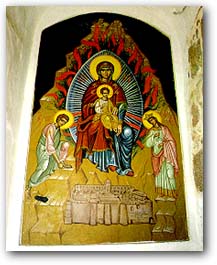
with archangels and saint Icon from St Catherine ''s, Sinai, 6 century, encaustic
Slide 8: St Catherine'’s Monastery, Sinai, Icon Christ![]()
Christ Pantokrator Ruler of All
St. Catherine’s Monastery, Sinai
Constantinople
mid – 6
encaustic painting on wood
84 x 45.5 cm, 33.1 x 19.4 in
6 Century.; Icon St. Peter, 6 C., St. Catherine ''s Sinai
Slide 9: St Catherine'’s Monastery, Sinai, Icon of orthodoxy(image not found)
1400, British Museum
Slide 10: St Catherine'’s Monastery, Sinai, St Luke painting the Virgin(image not found)
El Greco, 16 century, icon; Triumph of Orthodoxy, detail, ca. 1400, British Museum
Slide 11: Theokiste instructing her granddaughters![]()
Thekla, Anna, Anastasia, Pulcheria and Maria in the Veneration of Icons; Triumphal Procession of John I Tsimiskes into Constantinople with the Preslav icon; John Skylitzes, Synopsis Historiarum, mid 12 Century, Biblioteca Nacional, Madrid
Slide 12: St. Eirene, Istanbul, nave and apse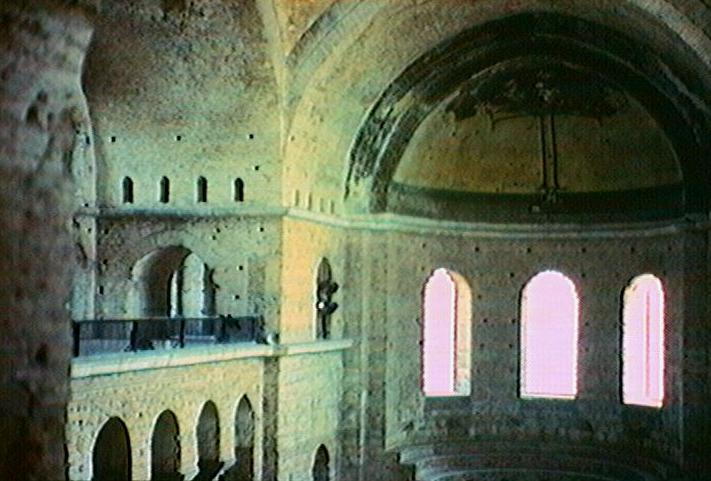
after 740, built by Constantine V
Slide 13: Khludov Psalter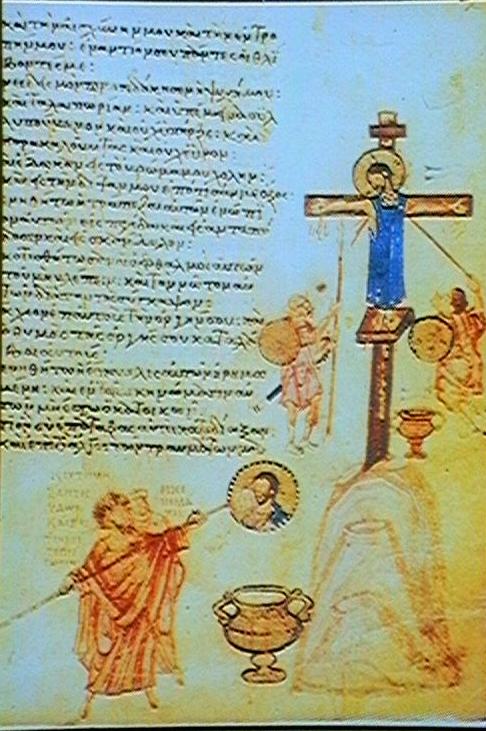
Moscow Historical Museum, soon after 843
Paris cod. gr. 923, Illustrated manuscript of John of Damscus
Slide 14: Sacra Parallela(image not found)
2 half 9 Century, Biblioth '' que nationale, Paris, John of Damascus, folio 208 r; icon painter
Paris, gr. 139,, 950, Biblioth '' que nationale, Paris
Slide 15: Paris Psalter David playing the harp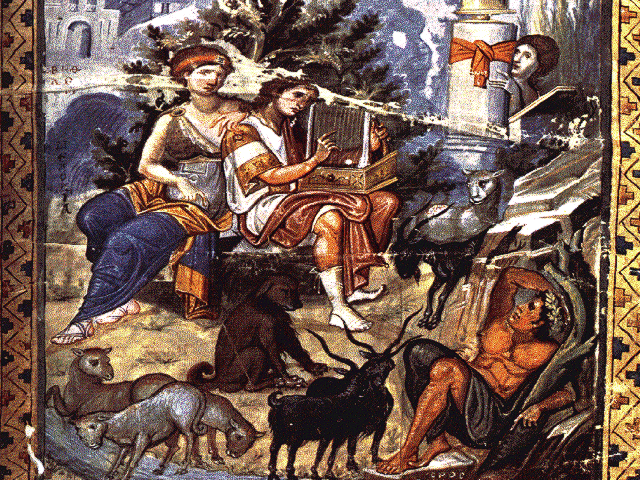
folio lv
Paris, gr. 139,, 950, Biblioth '' que nationale, Paris
Slide 16: Paris Psalter Crossing the Red Sea(image not found)
folio 419 v
The Defeat of the Men of Ai, sheet 10; Joshua Condemning the King of Ai, sheet 11;
Slide 17: Joshua Roll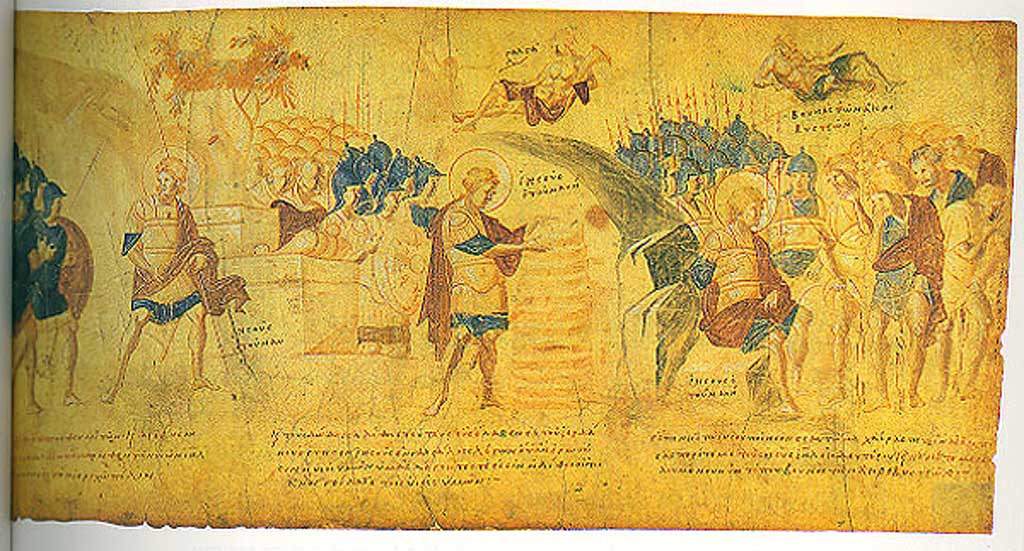
ink and colour washes on parchement,, 1 0 Century, Biblioteca Vaticana Apostolica
The Embassy of the Gibeonites, sheet 12, Joshua Roll
Slide 18: Joshua panels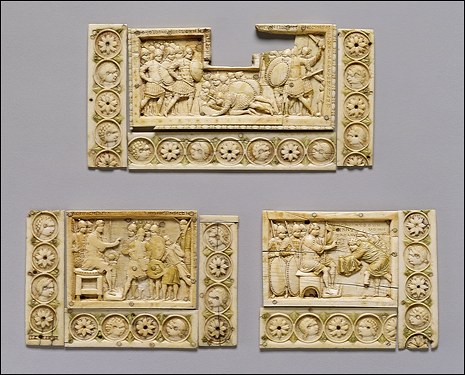
ivory, a) Joshua ''s ambush of the army at Ai; b) Joshua condemning the King of Ai; Joshua receiving ambassadors from Gibeon,, 10 c, Metropolitan Museum
Slide 19: Veroli Casket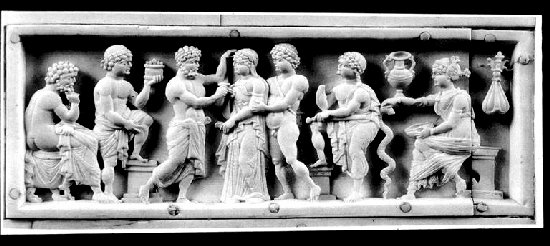
front: Young woman with naked man (Cstor or Hipplytos), horse, Bellophoros
with winged horses, young woman leans on an altar; Sacrifice of Iphigenia with Asikepios and
Hygeia at sides, and Achilles making an offering; ivory, tenth century, V&A
Veroli Casket, detail, Bellophoros, ivory, tenth century, V&A, detail
Lid: The Rape of Europa, Herakles playing the lyre, erotes and centaurs
Back, left side: erotes playing with a lion, stag, hound and eagle; Back, right side: Aphrodite and Ares (?), Rape of Europa, erotes and horse
Slide 20: Church of the Panaghia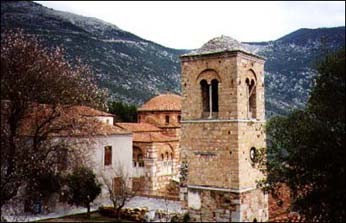
Hosios Loukas, Greece, second half 10 c.
Slide 21: Hosios Loukas, Narthex, Doubting Thomas
11 Century
Slide 22: Hosios Loukas, Katholikon Christ and Saints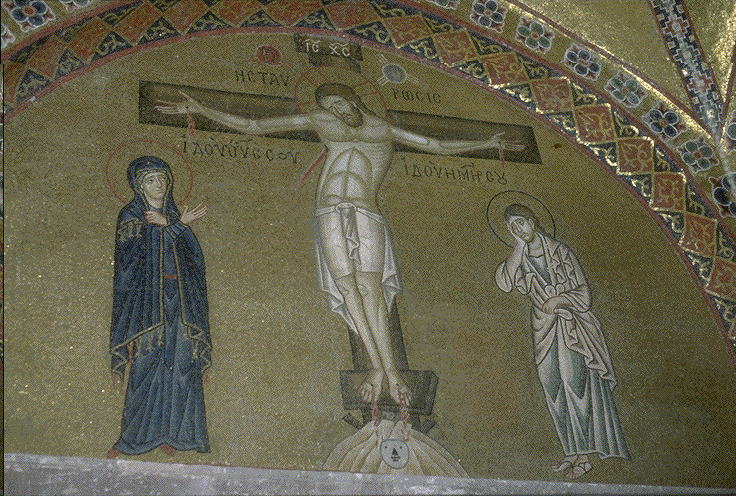
11 Century
Slide 23: Pantocrator Monastery, Constantinople, 1120-1136(image not found)
Slide 24: Ascension, Homilies of John Kokidnobaphos, Constantinople(image not found)
first half of 12 Century
Slide 25: Bronze horses, San Marco, Venice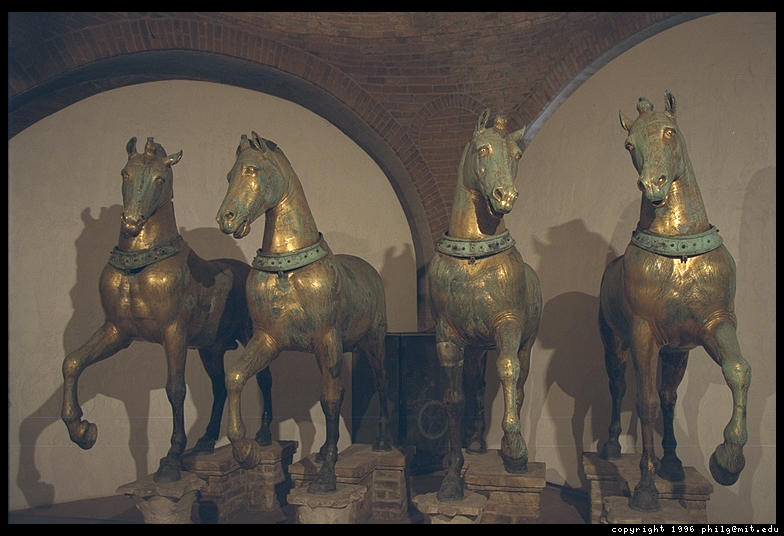
Greek or Roman, formerly in the hippodrome, Constantinople
Slide 26: Chalice of Emperor Romanos II, 959-63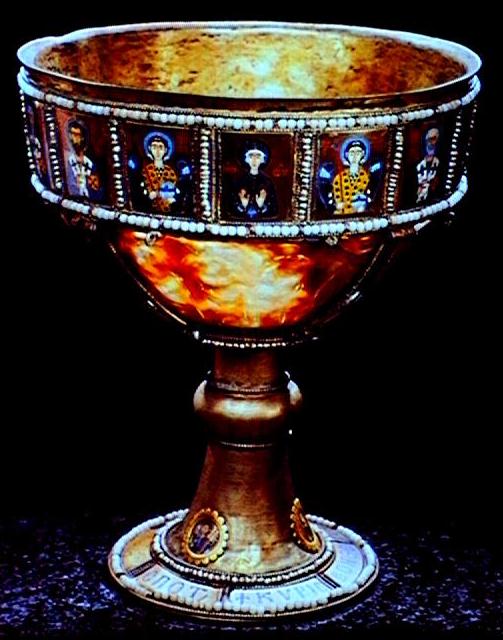
sardonyx, enamels and pearls, San Marco Treasury, Venice
Slide 27: Kariye Caami (Chora monstery), Istanbul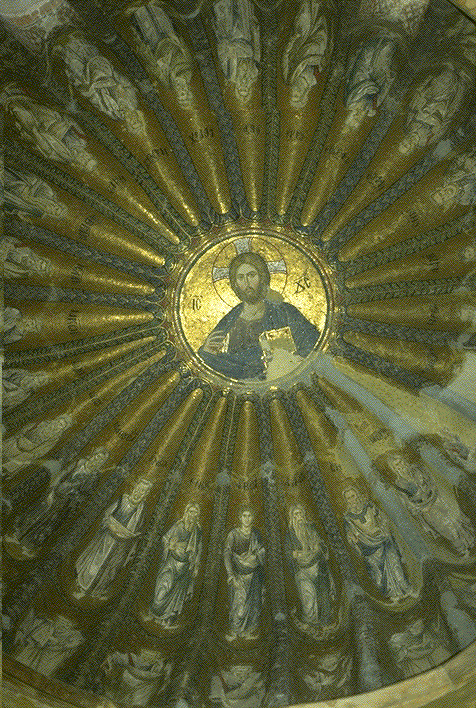
refounded by Theodore Metochites, 1316 – 1321
Slide 28: Kariye Caami, Parakklesion, Anastasis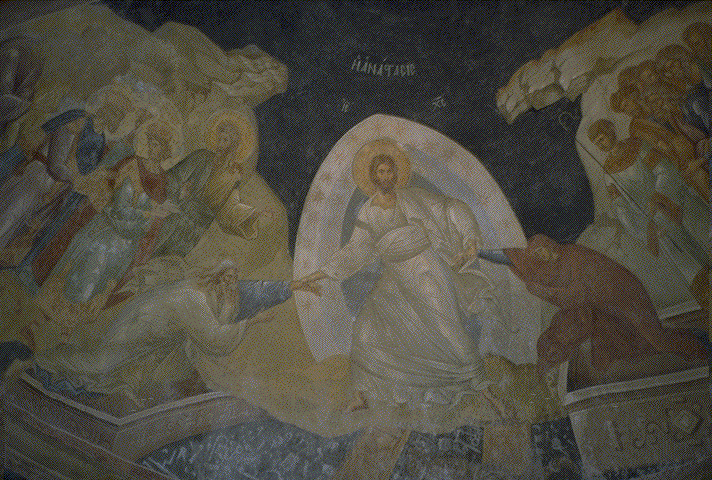
Important dates:
- Iconoclasm: First stage: 726 / 730-787, Second stage: 815 – 843
- Schism of Churches, east and west: 1054
- Latin occupation of Constantinople: 1204 – 1261
- Fall of Constantinople: 1453
Vocabulary:
Iconoclasm – belief in having no images either of God or of anything.
The Iconophiles: Irene (c. 750-803) and (812/13-c. 860)
Irene was an unlikely bride to the vehemently iconoclast Emperor Leo IV. He is portrayed, like his father Constantine V Kopronoymos, as a ruthless emperor, torturing and killing many iconophiles and icon painters. Irene, like the wives of her husband’s predecessors, was a pious icon venerator. While her husband was out persecuting iconophiles, Irene was secretly keeping painted icons (like the one pictured at right) in her quarters at the palace. The source Kedrenos states,
“In the mid-week of Lent he found under the pillow of his wife Irene two icons….As for his wife Irene, he rebuked here severely and set her at naught, saying, ‘Was this what you swore to my father the Emperor upon the fearsome and pure mysteries of our faith?’ She affirmed that she had not seen them ]note: the icons 23 January 2004. He spurned her and hand no more marital relations with her.”
Whether or not this account is true is disputable but it can be said that Leo IV so disapproved of Irene’s actions that when he died in 780, she changed direction of the empire entirely. In 776 Irene’s son Constantine VI was crowned at age five by Leo to ensure the passage of the throne through imperial lines. After her husband’s death, Irene managed to secure her place as regent for her minor son. She struck coins with her own image and name on the obverse and Constantine’s on the less important reverse. To secure their joint reign she arranged for her son a future marriage with Charlemagne’s daughter, Rotrud.
Irene delegated responsibility to trusted eunuchs to cover where she lacked in military ability. She concealed her religious convictions for under a year so as to not raise suspicion with Leo’s loyal supporters, then a coffin was conveniently discovered bearing the inscription:
“Christ will be born of the Virgin Mary and I believe in Him. O sun, you will see me again in the reign of Constantine and Irene”
thus reinstating the authority of iconophile propaganda. After careful planning and negotiation, in 787 Irene successfully abolished iconoclasm during the Seventh Ecumenical Council. The decision was enthusiastically supported by the public and clergy and the imperial pair was exalted as the ‘New Constantine and New Helena.’ As Constantine became of age his marriage betrothal was broken off and he was consequently torn. Irene is credited with the first use of a bride-show in which the most beautiful and noble young ladies were brought to be judged by the empress for selection as the successor to her throne. By way of one of these productions and new bride was chosen, much to the dismay of Constantine. From this point on Constantine and his mother became more and more disagreeable and differed on almost all accounts. Constantine, now of age to take the throne, was prevented from emperorship by his insistent mother. Rifts continued to grow and hostility mounted. Soon conspiracy was thick in the air at the palace and Irene was getting nervous. She concocted a counter-plot and had her son blinded to rid herself of any threat. The act was atrocious and the public was astonished, but Irene maintained control and continued to reign. Charlemagne requested her hand in marriage to unify the Eastern and Western empires but before she could accept, she was overthrown in revolution and exiled in the late 8th century. Irene was acclaimed as the restorer of icons until policy reverted in 815.
Theodora was also married to an iconoclast, Theophilos, in 830. The couple had five daughters and one son, all of whom were depicted on coinage at one time or another. The famous icon painter Lazarus was imprisoned under Theophilos. Theodora sent her daughters to their grandmother at a convent where she taught them to venerate icons (depicted at right), and this too was discovered by the emperor to his horror. The emperor’s jester is said to have discovered and revealed Theodora’s hidden icons, adding to the events putting strain on the union. Theophilos died of dysentery after a short reign of 12 years in 842 and Theodora was made regent with supervision until her son Michael became of age. She supported an ecclesiastical council in 843 which reinstated the use of icons. This action may have occurred through a belief that God no longer favored iconoclasm because of recent military failure. Theodora was not as power hungry as Irene and sincerely wanted her son to inherit the throne, but somehow he was convinced she was plotting against him and her most valued eunuch was assassinated. Ensuing treachery eventually saw the demise of her son and her power thwarted. Her restoration of the holy images remains here greatest achievement as it was lasting and memorable.
Iconoclasts – An iconoclast can be unpleasant company, but at least the modern iconoclast only attacks such things as ideas and institutions. The original iconoclasts destroyed countless works of art. Eikonoklasts, the ancestor of our word, was first formed in Medieval Greek from the elements eikn, “image, likeness,” and -klasts, “breaker,” from kln, “to break.” The images referred to by the word are religious images, which were the subject of controversy among Christians of the Byzantine Empire in the 8th and 9th centuries, when iconoclasm was at its height. In addition to destroying many sculptures and paintings, those opposed to images attempted to have them barred from display and veneration. During the Protestant Reformation images in churches were again felt to be idolatrous and were once more banned and destroyed. It is around this time that iconoclast, the descendant of the Greek word, is first recorded in English (1641), with reference to the Byzantine iconoclasts.
Katholikon – central church
Parelddesion – funerary chapel
Theotokos – mother of God
Anastasis – (Greek, “resurrection”) This is the representation of Christ bursting the gates of hell and releasing Old Testament figures said to have believed in him. One of the festival icons, it is also the Easter image of the Orthodox Church.
